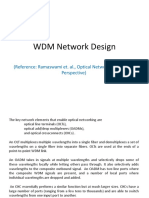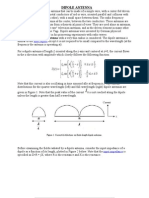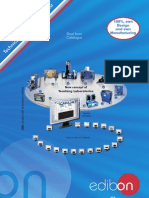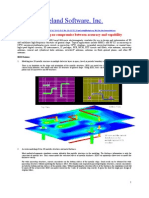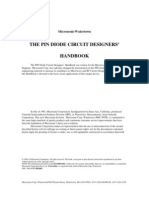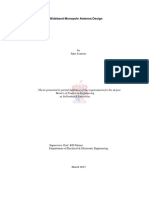CST Assignment
Uploaded by
Ahmed MaGdyCST Assignment
Uploaded by
Ahmed MaGdyMonopole Simulation on CST Microwave Studio
1. Build using modeler the following shown wire monopole placed above a square ground plane,
GND Plane
The parameters shown in the figure are: monopole length L = 35.625 mm, square
ground plane width W = 200 mm, wire diameter d = 0.3 mm, and gap width where discrete port
excitation is placed g = L/200.
1. Place the side absorbing boundary box walls touching the GND conducting plane (i.e. use
open boundary). This placement corresponds to the use of infinite ground plane. Place
the upper absorbing boundary at a distance above the tip of the monopole (i.e. use open
(add space) boundary). Plot the S-parameters between 1 GHz and 3 GHz, and find dipole
resonance frequency.
2. Plot the radiation pattern in the E-plane, and show it comply with the theoretical monopole
results.
3. Now instead of using absorbing boundaries touching the edges of the conducting square, use
absorbing boundaries placed at a distance from the structure in all directions (i.e. use open
(add space) for all boundaries). Plot again the radiation pattern in the E-plane and compare
it with the results obtained in part 3. Explain the difference.
You might also like
- Design of Pyramidal Horn Antenna For UWB ApplicationsNo ratings yetDesign of Pyramidal Horn Antenna For UWB Applications3 pages
- WDM Network Design: (Reference: Ramaswami Et. Al., Optical Networks-A Practical Perspective)No ratings yetWDM Network Design: (Reference: Ramaswami Et. Al., Optical Networks-A Practical Perspective)18 pages
- Design & Simulation of Pyramidal Horn Antenna For Navigation andNo ratings yetDesign & Simulation of Pyramidal Horn Antenna For Navigation and4 pages
- Design of A 24GHz Rectangular Microstrip Patch Antenna For Wireless ApplicationsNo ratings yetDesign of A 24GHz Rectangular Microstrip Patch Antenna For Wireless Applications7 pages
- The Gentleman'S Guide To Frequency Selective Surfaces100% (1)The Gentleman'S Guide To Frequency Selective Surfaces18 pages
- Design of Aperture Coupled Fed Micro-Strip Patch Antenna For Wireless CommunicationNo ratings yetDesign of Aperture Coupled Fed Micro-Strip Patch Antenna For Wireless Communication3 pages
- Design and Fabrication of A Microstrip Patch AntennaNo ratings yetDesign and Fabrication of A Microstrip Patch Antenna5 pages
- Circular Polarization and Polarization LossesNo ratings yetCircular Polarization and Polarization Losses12 pages
- Voltage Across The Terminals of A Receiving AntennaNo ratings yetVoltage Across The Terminals of A Receiving Antenna10 pages
- Complete Design of A Microstrip Line CouplerNo ratings yetComplete Design of A Microstrip Line Coupler6 pages
- Review of Microwave Imaging Algorithms For Stroke Detection: Jinzhen Liu Liming Chen Hui Xiong Yuqing HanNo ratings yetReview of Microwave Imaging Algorithms For Stroke Detection: Jinzhen Liu Liming Chen Hui Xiong Yuqing Han14 pages
- Frequency Selective Surface: A Modernized Efficient Way of Filtering in Microwave FieldNo ratings yetFrequency Selective Surface: A Modernized Efficient Way of Filtering in Microwave Field82 pages
- D-Band Frequency Tripler For Passive Imaging - Final 13th July100% (1)D-Band Frequency Tripler For Passive Imaging - Final 13th July4 pages
- Photonic Crystal Cavities: Nanophotonics and Integrated OpticsNo ratings yetPhotonic Crystal Cavities: Nanophotonics and Integrated Optics8 pages
- Bandwidth Enhancement of Microstrip Patch AntennaNo ratings yetBandwidth Enhancement of Microstrip Patch Antenna5 pages
- Phased Array Design Using Mathworks and ANSYS - 01No ratings yetPhased Array Design Using Mathworks and ANSYS - 018 pages
- MATLAB-CST Interfacing For A Micro-Strip Patch AntennaNo ratings yetMATLAB-CST Interfacing For A Micro-Strip Patch Antenna5 pages
- Coupler, Power Divider and Circulator in V-Band Substrate Integrated Waveguide Technology100% (1)Coupler, Power Divider and Circulator in V-Band Substrate Integrated Waveguide Technology10 pages
- Improved Design of The Vivaldi Antenna - E.gazutNo ratings yetImproved Design of The Vivaldi Antenna - E.gazut4 pages
- Design-and-Analysis-of-Dual-Band-Frequency-Selective-SurfaceNo ratings yetDesign-and-Analysis-of-Dual-Band-Frequency-Selective-Surface28 pages
- (MWRF0012) Simplified Method Eases The Design of Bandpass Filters100% (1)(MWRF0012) Simplified Method Eases The Design of Bandpass Filters4 pages
- Microstrip Stripline and CPW Design PDFNo ratings yetMicrostrip Stripline and CPW Design PDF27 pages
- AM NRSC Testing With The Loop Antenna (NRSC Bandwidth)100% (1)AM NRSC Testing With The Loop Antenna (NRSC Bandwidth)5 pages
- Optical and Microwave Technologies for Telecommunication NetworksFrom EverandOptical and Microwave Technologies for Telecommunication NetworksNo ratings yet
- Silica Optical Fiber Technology for Devices and Components: Design, Fabrication, and International StandardsFrom EverandSilica Optical Fiber Technology for Devices and Components: Design, Fabrication, and International StandardsNo ratings yet
- Microwave Filters for Communication Systems: Fundamentals, Design, and ApplicationsFrom EverandMicrowave Filters for Communication Systems: Fundamentals, Design, and ApplicationsNo ratings yet
- Niversity of Oronto Aculty of Pplied Cience and NgineeringNo ratings yetNiversity of Oronto Aculty of Pplied Cience and Ngineering4 pages
- FDTD Modeling of A Resistively Loaded Monopole For Narrow Borehole Ground Penetrating Radar F. Sagnard and C. FauchardNo ratings yetFDTD Modeling of A Resistively Loaded Monopole For Narrow Borehole Ground Penetrating Radar F. Sagnard and C. Fauchard12 pages
- ECE 621 Signaling & Synchronization: Fall 2017No ratings yetECE 621 Signaling & Synchronization: Fall 201747 pages
- Design of Double Balanced Gilbert Cell Mixer For WBAN ApplicationsNo ratings yetDesign of Double Balanced Gilbert Cell Mixer For WBAN Applications4 pages
- Using The Gate-Bulk Interaction and A Fundamental Current Injection To Attenuate IM3 and IM2 Currents in RF TransconductorsNo ratings yetUsing The Gate-Bulk Interaction and A Fundamental Current Injection To Attenuate IM3 and IM2 Currents in RF Transconductors10 pages
- A High Gain, Low Voltage Folded-Switching Mixer: With Current-Reuse in 0.18 CmosNo ratings yetA High Gain, Low Voltage Folded-Switching Mixer: With Current-Reuse in 0.18 Cmos4 pages
- Generalized Noise Analysis of Active Mixers by Simple Linear Periodic Time-Varying Circuit ModelNo ratings yetGeneralized Noise Analysis of Active Mixers by Simple Linear Periodic Time-Varying Circuit Model4 pages
- Direct Conversion Transmitter: NB-IOT TX RF/Analog Cairo University TeamNo ratings yetDirect Conversion Transmitter: NB-IOT TX RF/Analog Cairo University Team20 pages








